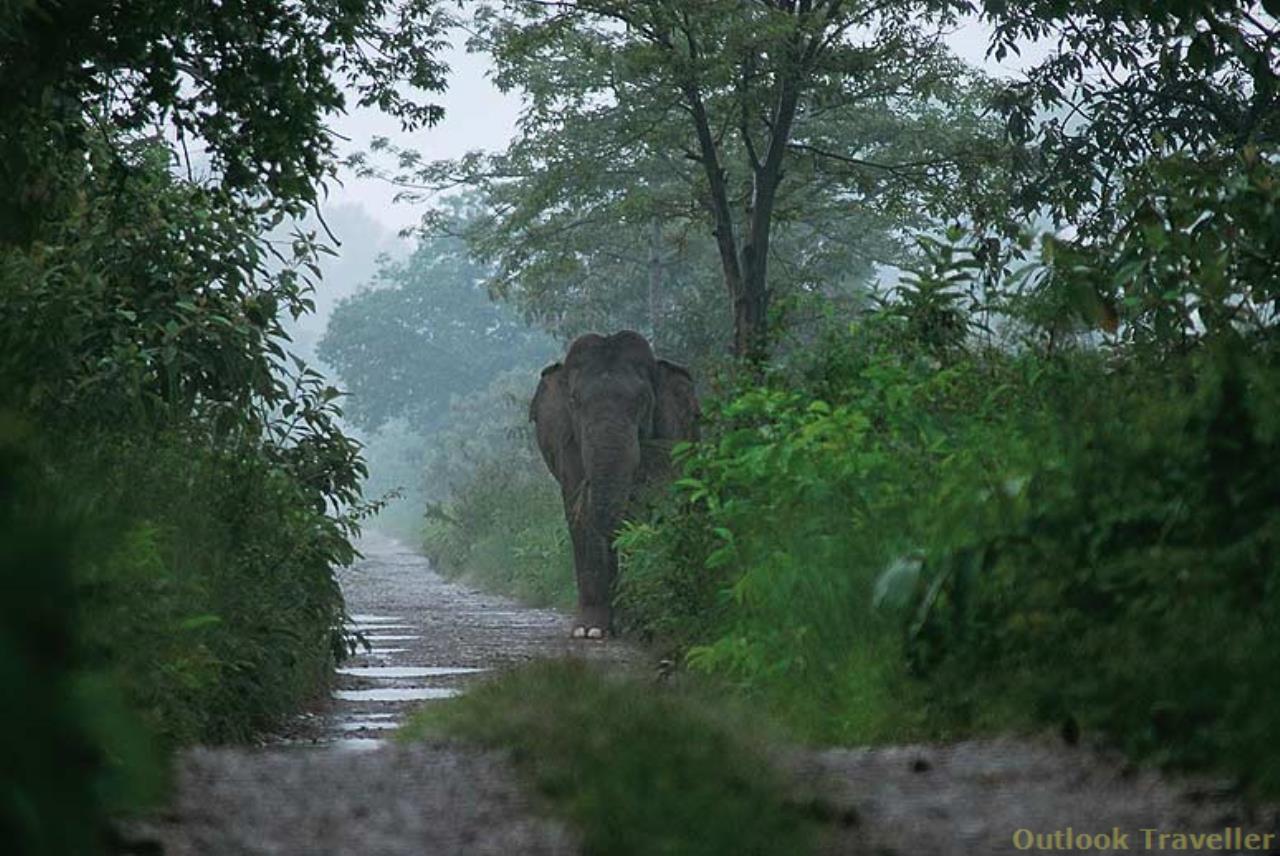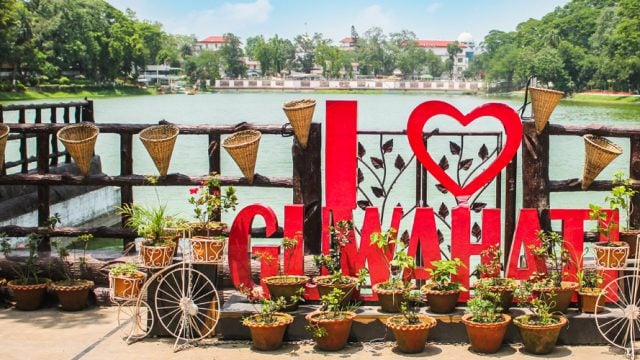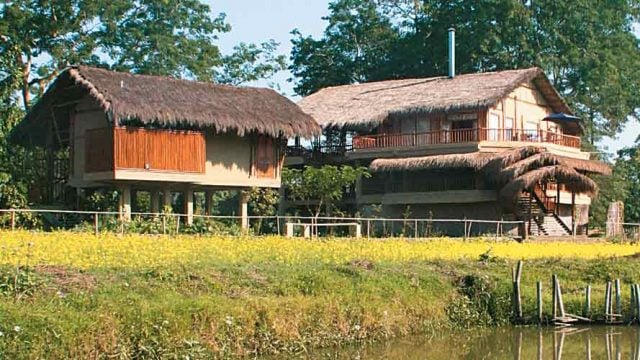“Don’t worry, everything will be fine,” says my guide, leading me towards a tunnel formed by thickly
His name is Buddheshwar, a happy coming together of Buddha and Eeshwar. It only adds to my unease — in this world even the benevolent ones trust the gun. My disquiet notwithstanding, these were good signs in Eastern Assam’s Manas National Park, a designated sanctuary that has the singular distinction of being a wildlife sanctuary, national park, biosphere hotspot, a Natural World Heritage Site, a Project Tiger and Project Elephant reserve and also one of the better known birding areas in the world. Perhaps Manas was indeed on the verge of shaking off its only dubious distinction — as a Unesco World Heritage Site in Danger.
This last moniker was forced upon the park following the Bodoland agitation through the 1980s and much of the 1990s, when this forest was transformed into a bloody hunting ground. It is widely accepted that the wildlife trade helped fund the Bodo revolution, though the Bodos disagree. They admit that they took shelter in the forests but blame the slaughter of animals on professional poachers. In the end, though, it was the forest that suffered. Grasslands were razed, animals slaughtered and trees felled indiscriminately, reducing the wilderness to little more than bush-choked wasteland.
But over the last few years, local initiatives and people like Buddheshwar have helped the forest heal again. A former poacher himself, Buddheshwar has a reputation every bit as mean as the forest he is to walk me through. By the time he pledged to protect instead of plunder, he had killed 80 tuskers, two tigers and a rhino. I don’t know whether it was his humility or the staggering number, but he was quick to change subjects when asked about the number of smaller animals — deer, hogs and a menagerie of others — he had despatched summarily for a chance at reincarnation.
Today, Buddheswar and some 200 volunteers have understood that there is more to gain from tourism than from poaching and, to this end, have volunteered to undo the damage under the aegis of the Manas Maozigendri Ecotourism Society (MMES), the first community-based ecotourism project in the Northeast formed with the help of Siliguri-based Help Tourism and Ashoka Holidays. The initiative came about after the Bodos signed an agreement in 2003, for the creation of a Bodoland Territorial Council.
Now trained in hospitality and groomed in tourism, these born-again conservationists not only take tourists around the jungle but also educate them on the importance of preserving wilderness areas. Guests can choose from patrolling on foot, bicycle, in jeeps and sometimes on elephant-back. The aim is to inculcate in visitors a respect for the wild. Members of the society also practise grassland management: burning tracts of grass before the monsoon to promote growth of new vegetation to attract herbivores.
Over the past five years, the MMES’s plans have seen fruition and the Unesco World Heritage Commission has termed it the most positive development towards the revival of Manas. The tiger has been spotted in Manas, and the one-horned rhinoceros, too, has made a comeback. And so I set out — heart in mouth, prayer on lips and Buddheshwar on my tail — into the forest. The route seemed oft used, the grass beaten down by plodding feet, a contrast to the mad tangle of vegetation on both sides of it.
Over time, the fragrance of damp earth, the bird calls and the silence gradually worked their way into my system, unknotting my muscles, soothing my brain and winning me over. I was just beginning to enjoy this walk when Buddheshwar, perhaps sensing that I was relaxing a bit too much, threw some trivia my way. The path we were walking on, he said, was exactly as wide as an elephant. “You know why?” “Because they made them! The elephants use this trail every evening to head to the river for a drink.”
The thought of a chance encounter was thrilling. Indeed, it would give me bragging rights for a lifetime, but then again chances were that my life expectancy would be drastically reduced to a few seconds, especially because elephants live long and are supposed to have good memories. And some might not remember Buddheshwar very fondly.
But I was not giving Buddheshwar enough credit. The few hours in the bush with him made feel me like an ignorant infant. Every rustle, even the silence, seemed to speak to him. Little more than a shadow in the forest, he seemed to move on padded feet, every so often cupping his hands behind his ear or dropping low to the ground to inspect something that I never would understand, or part a curtain of leaves to sneak a look at the grassland beyond. And each time he paused, he would have something to show me. I could see how he had bagged 80 tuskers — doubly so after he crept up, with me in tow, to within 20m of a grazing pachyderm.
I have never had a more glorious adventure, and with Buddheshwar or any of the other volunteers, I wouldn’t think twice before doing it again. When the walk was finally over, I sank happily exhausted onto the bed in my hut at Manas Jungle Camp, the MMES village-stay initiative. Dinner was a simple but tasty affair of rice, chapatis, dal, curry and pork, by the light of a lantern and to the accompaniment of an orchestra of crickets and frogs. Before falling asleep, I watched in silent stupefaction as the forest glowed in the ethereal light from fireflies.
The next day, a bumpy drive took us to the Mothanguri forest bungalow, on the banks of the river that gives the park its name. An exuberant river, Manas marks the border between India and Bhutan, and between the plains and the hills. The other bank heaves high above ground in a rapid succession of topographical hiccups, its woods unmanicured, informal and raffish. And thanks to this ecotourism initiative, I could swear that if I looked from the other side, this side of Manas would look just as beautiful.
The information
Getting there
By Air Guwahati is the closest airport. Manas NP is 176km/4hrs by road from Guwahati. Roads are bad, regardless of whether you take the Barpeta Road, the traditional approach, or the alternative via Bhawanipur. The Manas Maozigendri Ecotourism Society (MMES) headquarters are to the east of the park’s core area. There are few buses to this area so it’s best to hire a taxi from Guwahati (about Rs 2,000).
By rail The nearest railhead is Barpeta Road (30km), connected to Delhi by the Brahmaputra Mail and the Awadh Express, and to Kolkata by the Guwahati Exp, Kanchenjunga Exp and Kamrup Exp.
Manas National Park
The park is spread over 2,837 sq km. It is home to the tiger, wild buffalo and gaur, apart from sambar and swamp deer. The park mostly comprises Eastern Himalayan moist mixed deciduous forest, sometimes dense enough to cut out all sunlight. There is also an alluvial grassland in the eastern part. The park is in the watershed area of the Manas, Hakua and Beki rivers. In 2002, the Manas Park was designated as the core zone of the Buxa-Manas Elephant Reserve under Project Elephant. The forest, however, extends into Bhutan, where it is known as the Royal Manas Park.
Where to stay
MMES runs the Manas Jungle Camp with very basic huts. CONTACT Huts can be booked by writing to MMES at P.O. Khamardaisa 781330, Dist. Bagsa, BTAD, Assam or calling them at 03666-268052. For details on packages, contact Help Tourism (0353-2433683, www.help tourism.com) or call Raj Basu at 9733000444. The tariff ranges between Rs 1,300 and Rs 2,500 per person per night.
What else to do
This is excellent tea country — visit the Fatemabad Tea Estate for a tour of their factory, or take a pretty walk through their estate. Also walk through the Bodo villages adjacent to the park where there’s a cooperative women’s weaving centre.
When to go
The best time to visit the park is between November and March.
Manas National Park
one horned rhinoceros
Leave a Reply
You must be logged in to post a comment.





